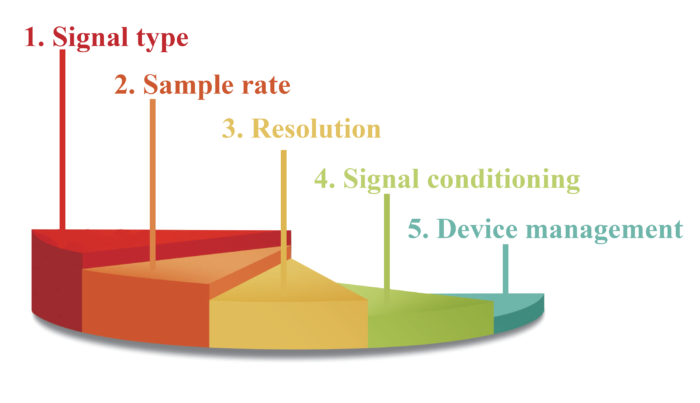How to Choose the Best DAQ Hardware for Your Measurement System
With an assortment of ADLINK data acquisition (DAQ) devices to choose from, there are a few critical questions to ask to determine the right one. Does this DAQ system match my resolution and accuracy requirements? How intuitive is the user interface for set up? How difficult is it to reconfigure for new applications? These considerations, and others, are addressed in the sections below.
- Signal type
Various sensors and transducers produce input signals, including thermocouples, thermistors, RTDs, strain gauges, accelerometers, microphones, and proximity probes. The DAQ should support the sensors and transducers in the system. Multifunction DAQ devices have a fixed channel count to measure analog inputs, generate analog outputs, measure and generate digital signals, and counters. The combination of I/O options allows flexibility far beyond the capabilities of single-function DAQ devices, but be sure the device includes enough of the required types for your specific application. - Sample rate
Measured in S/s (samples per second), this is the number of samples taken every second. Higher sample rates provide a more detailed representation of input measurements and generate a closer reproduction of the full signal. Higher sampling rates also allow for better analysis of signals. - Resolution
Measured in bits, this is the number of data bits used to represent each signal sample. Typical values are 4-bit, 8-bit, 16-bit, 24-bit, and 32-bit. Although a simplistic look is that more is better, more bits also put a more considerable strain on processing hardware, but the more bits, the more precise the representation of a single sample. - Signal conditioning
Signal conditioning processes the input signal so that it is usable by the system. Input signals, typically only mV, need amplification for optimal ADC processing, while high-voltage signals need attenuation. Filtering, excitation, and linearization are also necessary for best performance, removing high-frequency noise from thermocouple measurements being one example. Many DAQ devices provide built-in signal conditioning hardware. - Device management
Device management becomes increasingly difficult as more DAQ devices are added to the measurement system setup. A central device management utility simplifies the management process by allowing universal device control from a single computer. Additionally, utilizing dropdown menus and an intuitive graphical user interface eliminates the difficulties of command-line based approaches. Fewer obstacles to setup mean quicker setup

